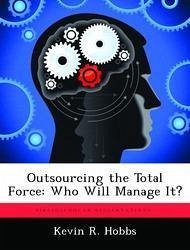
Better, Faster, Cheaper

PAYBACK Punkte
7 °P sammeln!
The erosion of Americaâs industrial base since World War II has affected national security by decreasing the available production and intellectual capacity. Some factors attributing to this phenomenon are the reduction in the number of firms in the defense industry, budgetary issues brought about by todayâs fiscally constrained environment, the practice of outsourcing capabilities overseas, the lack of a threat to state survival, and the increased specialization of the defense industrial base. Additionally, the defense acquisition organizational structure is out of balance. To function effic...
The erosion of Americaâs industrial base since World War II has affected national security by decreasing the available production and intellectual capacity. Some factors attributing to this phenomenon are the reduction in the number of firms in the defense industry, budgetary issues brought about by todayâs fiscally constrained environment, the practice of outsourcing capabilities overseas, the lack of a threat to state survival, and the increased specialization of the defense industrial base. Additionally, the defense acquisition organizational structure is out of balance. To function efficiently and effectively, defense acquisition must strike a balance between the requirements generation and approval process, the budgeting process, and the method by which defense acquisition professionals acquire materiel solutions. However, the lack of common oversight, prioritization and the conflicting timelines of the three decision support systems affect national security by limiting the options and capabilities available to the warfighter. To this point, Department of Defense leadership has tried to remedy the problem by placing emphasis on reforming how defense acquisition professionals go about procuring weapon systems under the auspices of "acquisition reform." However, acquisition professionals and Department of Defense (DoD) leadership are wasting their time because the current effort simply addresses symptoms of the problem, not the problem itself. The real dilemma in the defense acquisition system is the incompatibility in the "reward system" of the various stakeholders in defense acquisitions. Solving the overall problems in the defense acquisition enterprise requires a more robust and flexible industrial base, more interaction and harmony between the acquisition decision support systems and adequately addressing the core interests of the various stakeholders in the defense acquisition enterprise. Until then, the acquisitions community will never see true reform. This work has been selected by scholars as being culturally important, and is part of the knowledge base of civilization as we know it. This work was reproduced from the original artifact, and remains as true to the original work as possible. Therefore, you will see the original copyright references, library stamps (as most of these works have been housed in our most important libraries around the world), and other notations in the work. This work is in the public domain in the United States of America, and possibly other nations. Within the United States, you may freely copy and distribute this work, as no entity (individual or corporate) has a copyright on the body of the work. As a reproduction of a historical artifact, this work may contain missing or blurred pages, poor pictures, errant marks, etc. Scholars believe, and we concur, that this work is important enough to be preserved, reproduced, and made generally available to the public. We appreciate your support of the preservation process, and thank you for being an important part of keeping this knowledge alive and relevant.












